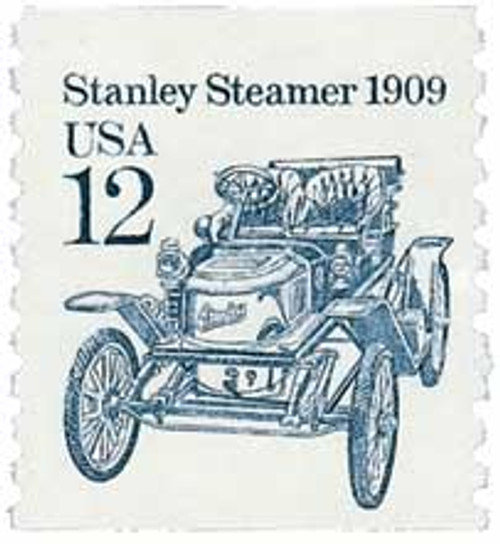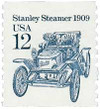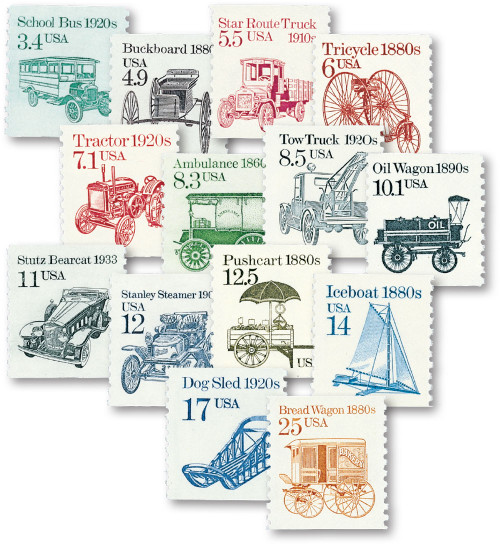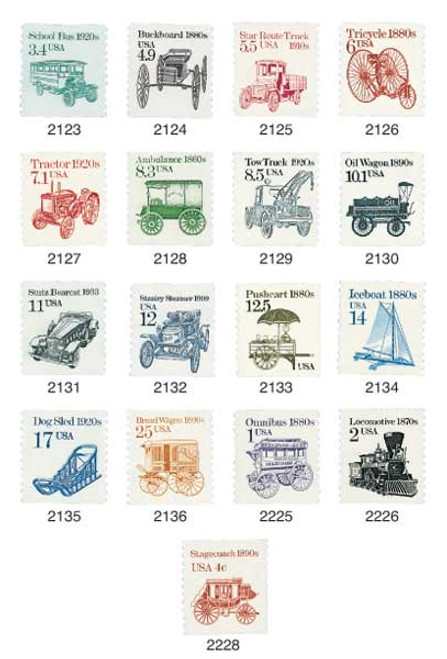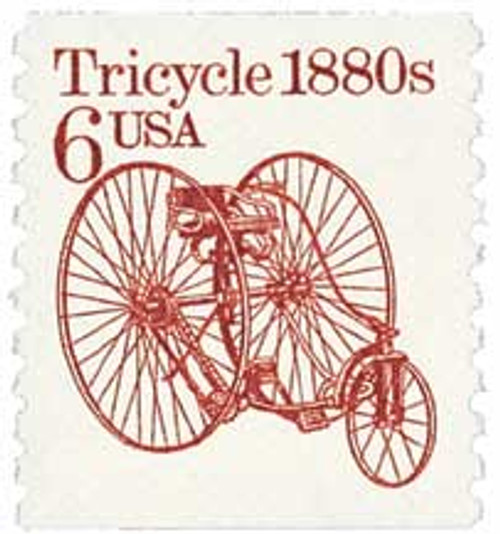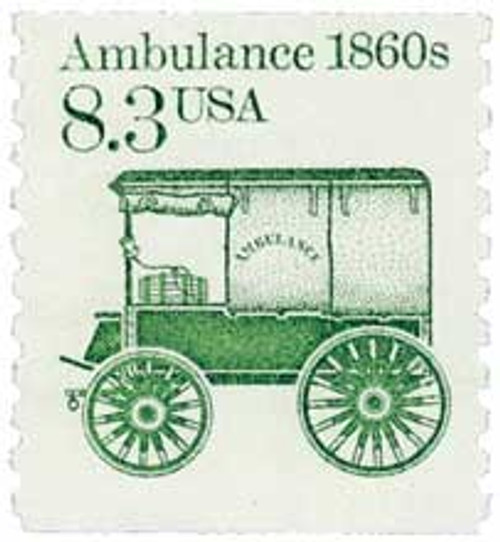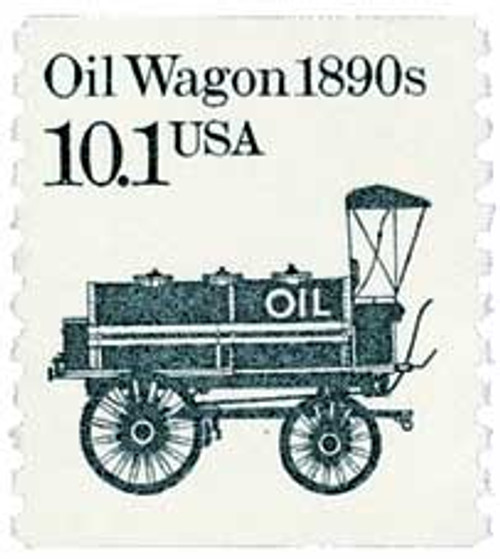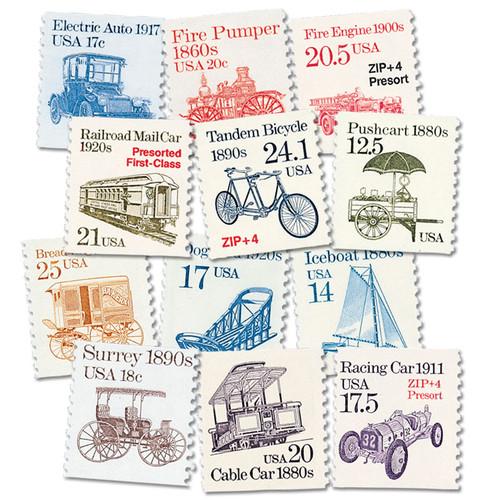
# 2132 - 1985 12c Transportation Series: Stanley Steamer, 1909
U.S. #2132
1985 12¢ Stanley Steamer, 1909
Transportation Series
- First stamp issued to cover the first-class bulk postcard presort rate
- The Stanley Steamer was a fast, reliable and safe steam-powered alternative to vehicles that used potentially explosive kerosene heated pressure boilers
Stamp Category: Definitive
Series: Transportation
Value: 12¢; the rate for first-class bulk presorted postcards
First Day of Issue: April 2, 1985
First Day City: Kingfield, Maine
Quantity Issued: 29,625,000
Printed by: Bureau of Engraving and Printing
Printing Method: Engraved
Format: Coils of 500 and 3,000
Perforations: 10 Vertical
Color: Dark blue
Why the stamp was issued: To pay the new first-class postcard presort rate for bulk mailers sending 500 pieces or more presorted to at least 50 pieces for three-digit ZIP codes or 10 for full five-digit ZIP codes.
About the stamp design: This was Ken Dallison’s first Transportation stamp, though he had designed several airmails before. He based his stamp art on old photos and remodeled 1909 Stanley Steamers.
Special design details: The 12¢ Stanley Steamer stamp was available with and without a precancel. #2132 has no precancel, while #2132a has a precancel. Precancels are stamps canceled before being sold, to make mailing faster and cheaper for customers with large amounts of mail. Bulk mailers use precancels, then pre-sort their mail and save money. The USPS makes these stamps available with and without precancels for two reasons. One reason is to create another variety for stamp collectors. The other, is so the stamps can be used as add-on postage for packages slightly overweight.
First Day City: This stamp’s First Day ceremony was held at the Kingfield Elementary School in Kingfield, Maine. Kingfield was the birthplace of the Stanley brothers who designed the Stanley Steamer.
About the Transportation Series: On May 18, 1981, the USPS issued the first stamp in the Transportation Series, US #1907, picturing the Surrey, a doorless four-wheeled carriage. For the first time in US history, a coil stamp featured its own unique design rather than simply copying that of the current definitive stamp. Over 50 more coil stamps would be issued over the course of the next 15 years, each picturing a different mode of transportation. All of these types of transportation were used since American independence.
The various denominations provided face values to exactly match the rates for several categories of Third-Class mail (bulk rate and quantity-discounted mail). As the rates changed, new stamps with new values were added. Never before had a stamp series included so many fractional cent values.
The Bureau of Engraving and Printing printed most of the stamps in the Transportation Series, although private contractors printed a few. All but a few of the later stamps were produced by engraved intaglio. Differences in precancels, tagging, paper and gum provide a large number of varieties.
Scott Catalog separates the Transportation stamps into four groups. The stamps in the first group (#1897-1908) generally have the denomination in small type with a “c” next to it. These stamps were printed on the Cottrell rotary press, which joined together two plates to make a sleeve. The gaps between these plates created depressions where ink would collect and create joint lines on the stamps. Later issues were printed on a different press and didn’t have these joint lines.
The second group (#2123-36) had larger numbers with no “c.” The third group (#2252-66) was similar in appearance to the second group, but service inscriptions were added to the designs. These stamps also used a variety of paper and gum as well as different types of tagging. The fourth group (#2451-68) marked the end of fractional values. Now bulk mailers would use either the 5¢ or 10¢ stamp and then pay the difference from the actual postage rate.
The last stamp in the Transportation Series, the 20¢ Cog Railway, was issued on June 9, 1995, at the TEXPEX ’95 stamp show in Dallas, Texas. This marked the end of the largest US definitive series up to that time. Three new series would eventually replace it – American Transportation, American Culture, and American Scenes. Additionally, the Great Americans would go on to become the largest American definitive series.
History the stamp represents: The Stanley Steamer was a steam-powered automobile developed by twin brothers Francis E. Stanley and Freelan O. Stanley. The Maine natives’ innovative design virtually eliminated the risk of explosion in kerosene-heated pressure boilers. The powerful Stanley Steamers were fast, reliable, and competitively priced.
In 1906, the Stanley Rocket set a world land speed record at 127.7 miles per hour at the Daytona Beach Road Course. The record is the longest-standing official land speed record for a steam car. However, the Stanley Motor Carriage Company was unable to compete with the popularity of the internal combustion engine and closed in 1917. Several attempts to revive steam-powered autos have been made.
U.S. #2132
1985 12¢ Stanley Steamer, 1909
Transportation Series
- First stamp issued to cover the first-class bulk postcard presort rate
- The Stanley Steamer was a fast, reliable and safe steam-powered alternative to vehicles that used potentially explosive kerosene heated pressure boilers
Stamp Category: Definitive
Series: Transportation
Value: 12¢; the rate for first-class bulk presorted postcards
First Day of Issue: April 2, 1985
First Day City: Kingfield, Maine
Quantity Issued: 29,625,000
Printed by: Bureau of Engraving and Printing
Printing Method: Engraved
Format: Coils of 500 and 3,000
Perforations: 10 Vertical
Color: Dark blue
Why the stamp was issued: To pay the new first-class postcard presort rate for bulk mailers sending 500 pieces or more presorted to at least 50 pieces for three-digit ZIP codes or 10 for full five-digit ZIP codes.
About the stamp design: This was Ken Dallison’s first Transportation stamp, though he had designed several airmails before. He based his stamp art on old photos and remodeled 1909 Stanley Steamers.
Special design details: The 12¢ Stanley Steamer stamp was available with and without a precancel. #2132 has no precancel, while #2132a has a precancel. Precancels are stamps canceled before being sold, to make mailing faster and cheaper for customers with large amounts of mail. Bulk mailers use precancels, then pre-sort their mail and save money. The USPS makes these stamps available with and without precancels for two reasons. One reason is to create another variety for stamp collectors. The other, is so the stamps can be used as add-on postage for packages slightly overweight.
First Day City: This stamp’s First Day ceremony was held at the Kingfield Elementary School in Kingfield, Maine. Kingfield was the birthplace of the Stanley brothers who designed the Stanley Steamer.
About the Transportation Series: On May 18, 1981, the USPS issued the first stamp in the Transportation Series, US #1907, picturing the Surrey, a doorless four-wheeled carriage. For the first time in US history, a coil stamp featured its own unique design rather than simply copying that of the current definitive stamp. Over 50 more coil stamps would be issued over the course of the next 15 years, each picturing a different mode of transportation. All of these types of transportation were used since American independence.
The various denominations provided face values to exactly match the rates for several categories of Third-Class mail (bulk rate and quantity-discounted mail). As the rates changed, new stamps with new values were added. Never before had a stamp series included so many fractional cent values.
The Bureau of Engraving and Printing printed most of the stamps in the Transportation Series, although private contractors printed a few. All but a few of the later stamps were produced by engraved intaglio. Differences in precancels, tagging, paper and gum provide a large number of varieties.
Scott Catalog separates the Transportation stamps into four groups. The stamps in the first group (#1897-1908) generally have the denomination in small type with a “c” next to it. These stamps were printed on the Cottrell rotary press, which joined together two plates to make a sleeve. The gaps between these plates created depressions where ink would collect and create joint lines on the stamps. Later issues were printed on a different press and didn’t have these joint lines.
The second group (#2123-36) had larger numbers with no “c.” The third group (#2252-66) was similar in appearance to the second group, but service inscriptions were added to the designs. These stamps also used a variety of paper and gum as well as different types of tagging. The fourth group (#2451-68) marked the end of fractional values. Now bulk mailers would use either the 5¢ or 10¢ stamp and then pay the difference from the actual postage rate.
The last stamp in the Transportation Series, the 20¢ Cog Railway, was issued on June 9, 1995, at the TEXPEX ’95 stamp show in Dallas, Texas. This marked the end of the largest US definitive series up to that time. Three new series would eventually replace it – American Transportation, American Culture, and American Scenes. Additionally, the Great Americans would go on to become the largest American definitive series.
History the stamp represents: The Stanley Steamer was a steam-powered automobile developed by twin brothers Francis E. Stanley and Freelan O. Stanley. The Maine natives’ innovative design virtually eliminated the risk of explosion in kerosene-heated pressure boilers. The powerful Stanley Steamers were fast, reliable, and competitively priced.
In 1906, the Stanley Rocket set a world land speed record at 127.7 miles per hour at the Daytona Beach Road Course. The record is the longest-standing official land speed record for a steam car. However, the Stanley Motor Carriage Company was unable to compete with the popularity of the internal combustion engine and closed in 1917. Several attempts to revive steam-powered autos have been made.

